For betting and raising a few different variations are possible. No Limit, as in No Limit Texas Hold’em, is one of the options. In most cases this variation is shortened to Texas Hold’em. But there are endless possibilities. Below is a list with a short explanation of the betting options.
No limit
Simply put there’s no limit on the stakes when you play No Limit. There is however a minimum of 1bb (Big Blind) or the double of the raise before you. There’s no maximum meaning you can always go all-in, no matter how many chips you have. No Limit is without a doubt the most played variation in Texas Hold’em. In some other game variations another form of betting is picked.
Pot limit
We use Pot Limit as a form of betting in Texas Hold’em as well, but a lot less than No Limit. In Omaha, a game format with 4 cards per player in hand, this betting form is the norm.
In Pot Limit your bets or raises are bound to a maximum. That maximum equals to the pot. In case there is € 50 in the pot, you can bet/raise for a maximum of € 50. In Pot Limit it’s not allowed to go all-in when you play more than the pot. In Omaha you mostly play Pot Limit because this guarantees the playability of the game. You can’t just go all-in whenever you have a good hand. This way you get to see the Flop more often and not only the players with the best hand are in.
To calculate the pot you count everything on the table. All bets are counted, including your own bet. Then you raise this amount.
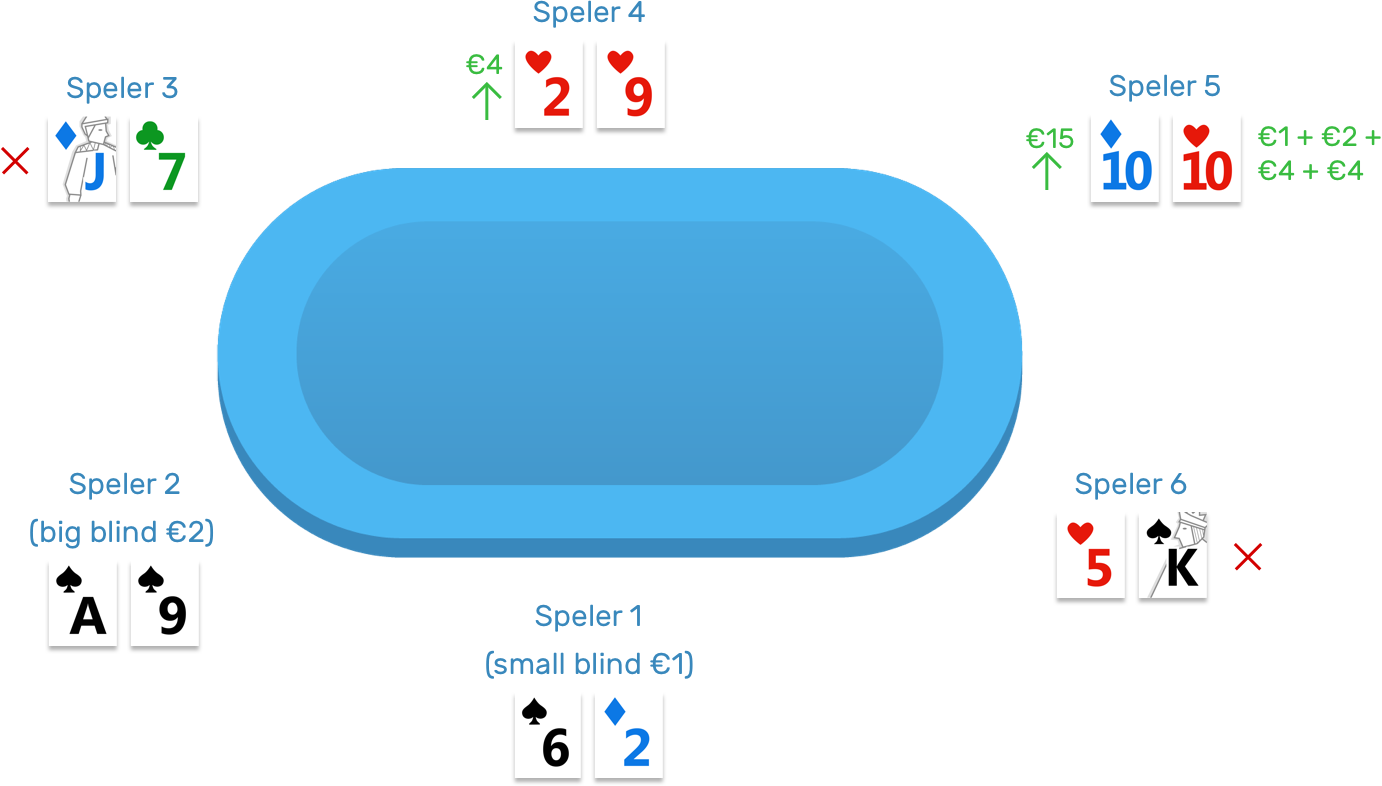
- Player 1Places Small Blind € 1.
- Player 2Places big Blind € 2.
- Player 3Folds.
- Player 4Raises to € 4.
- Player 5Wants to raise the pot: he announces this. First he will add € 4 to be equal to the raise of Player 4. The pot totals then to € 11 (€ 1 + € 2 + € 4 + € 4) Then he can raise the pot: he raises an extra € 11. Player 5 has raised a total of € 15.
- Player 6Folds.
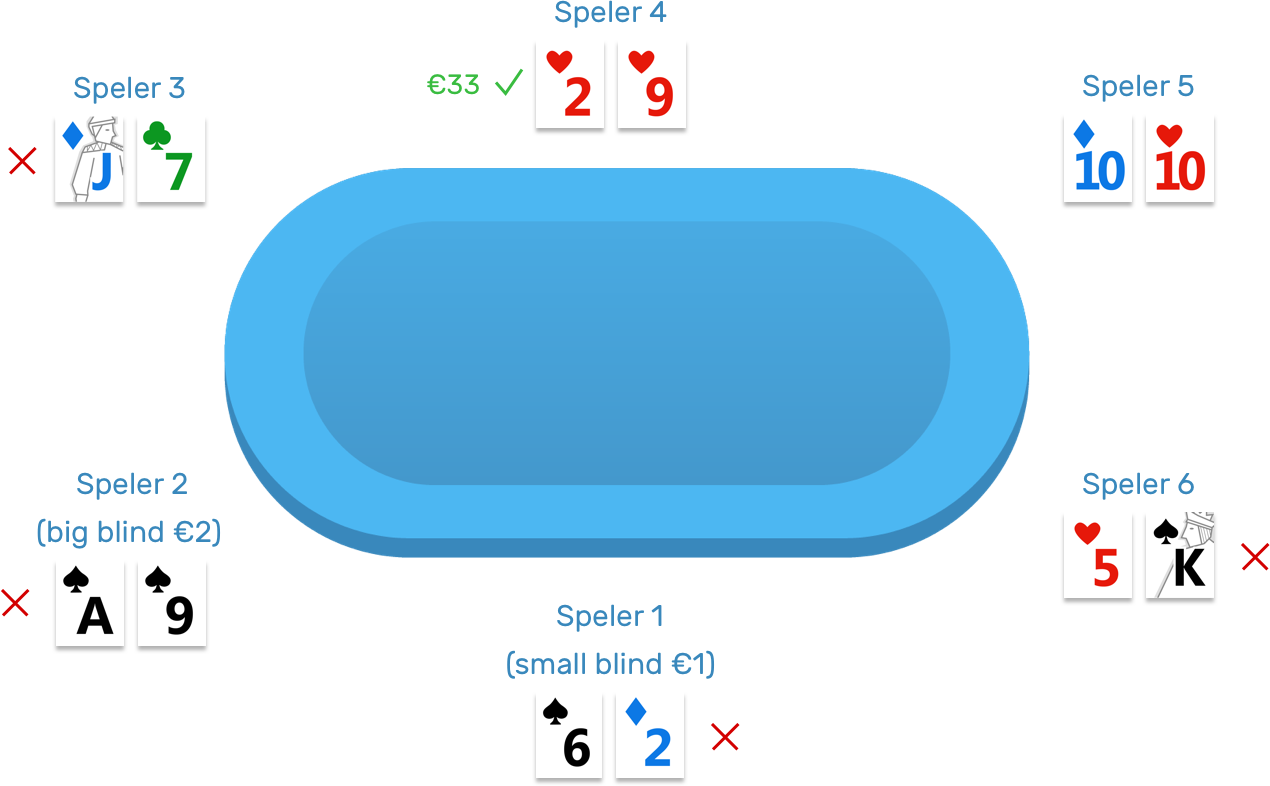
- Player 1Checks.
- Player 2Bets € 10.
- Player 4Calls, which makes the pot € 33.
After the flop the maximum bet is € 33. By betting and raising this maximum can go up.
Limit
Next to No Limit and Pot Limit we also have the Limit variation. This betting form mostly appears in other poker games such as mixed games. In mixed games different games are played together. In Limit betting the allowed amounts to bet or raise are fixed.
Limit on stakes
When you take a look at Texas Hold’em for example you are only allowed before the flop and on the flop a maximum of 1 big blind raise. On the turn and river you can raise the double: so per 2 big blinds.
An example with blinds € 1 – € 2
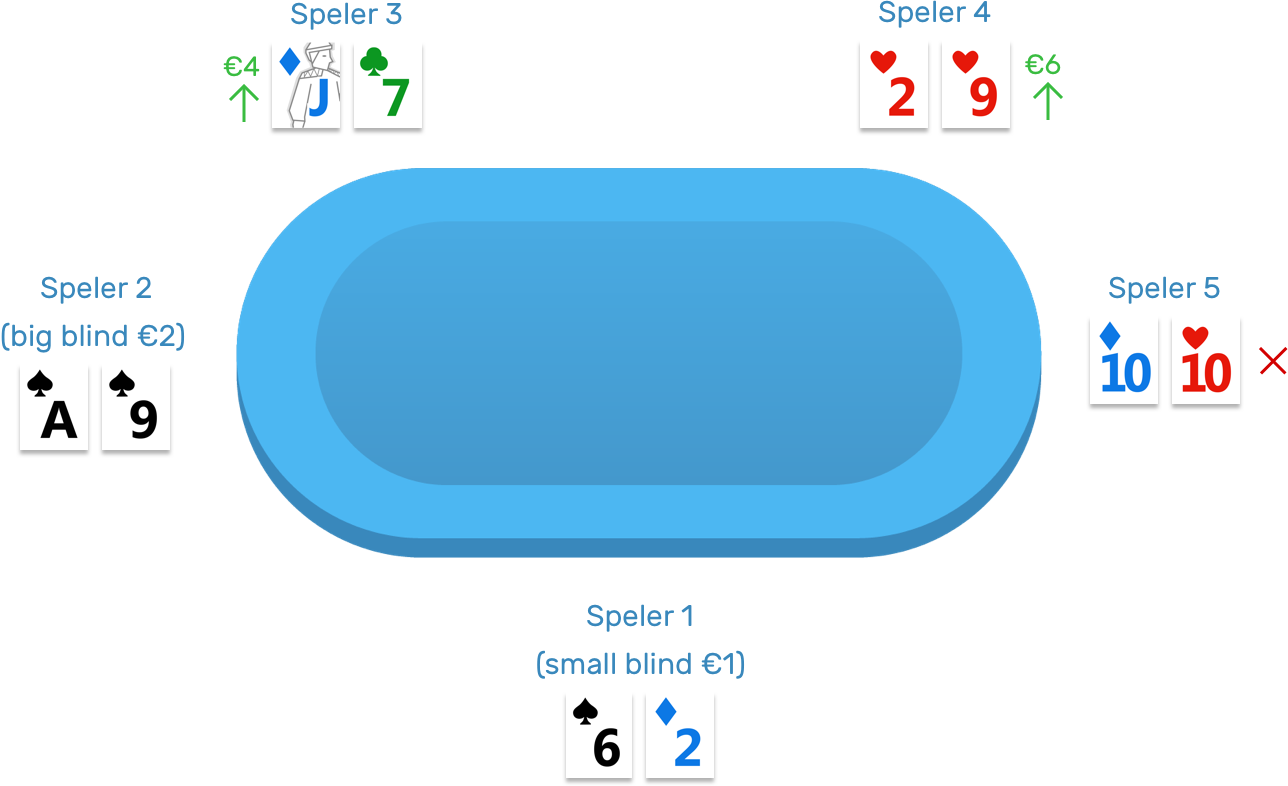
- Player 1Bets € 25.
- Player 2Calls € 25.
- Player 3Folds.
- Player 4Wants to raise to € 6.
- Player 5Folds.
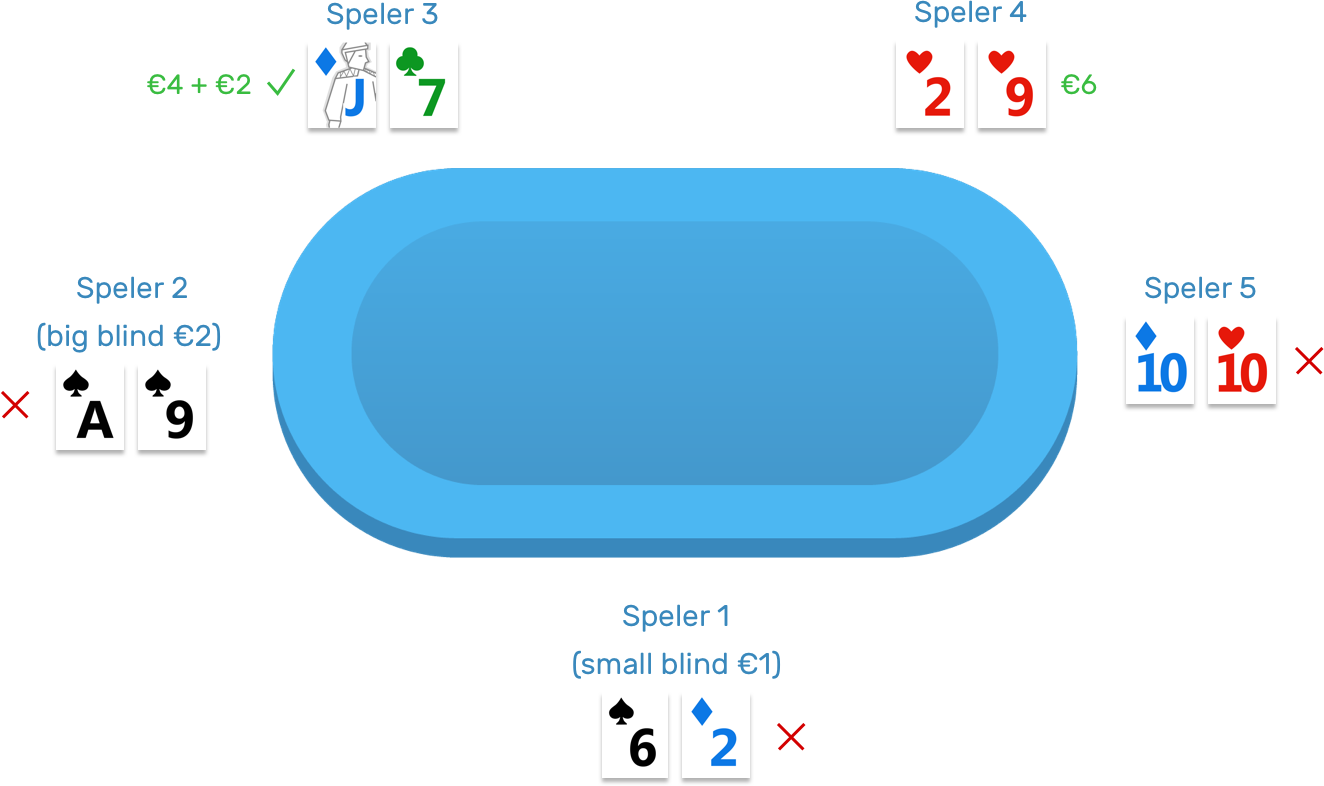
- Player 1Folds.
- Player 2Folds.
- Player 3Calls and adds € 2.
Actual bets and raises are done per € 2 (1 big blind). When the players reach the turn and want to bet it is done per € 4 (2 big blinds). If player 3 bets on the turn it is for € 4. Player 4 can raise to € 8. Player 3 reraises again to € 12 and player 4 could call. On the river the same limits as the turn count.
Limit on number of raises
Often there is a limit on the number of raises that you can make. In most cases this means that a bet plus 3 raises can be made. After that only calling or folding is allowed.
When we focus on the example of blinds € 1 – € 2 the maximum is at € 8 before and on the flop. This is the maximum of a big blind/bet and 3 raises of € 2 each. On the turn and river the maximum is at € 16 (a bet and 3 raises of € 4 each).
2 other betting concepts are an all-in bet and a side pot.
All-in bet
If a player bets all his remaining chips he’s all-in. He can’t lose more chips than the ones on the table. On top of that he can’t win any more than the ones he put on the table. As soon as a player is all-in and another player has paid a showdown happens. The two (or more) players that are all-in show their hands after the river is on the table. In a tournament the hands have to be shown face-up. In a cash game players can throw away their cards face-down if they want. When the latter is done, the player gives up the pot, unless his opponent has also thrown away his cards.
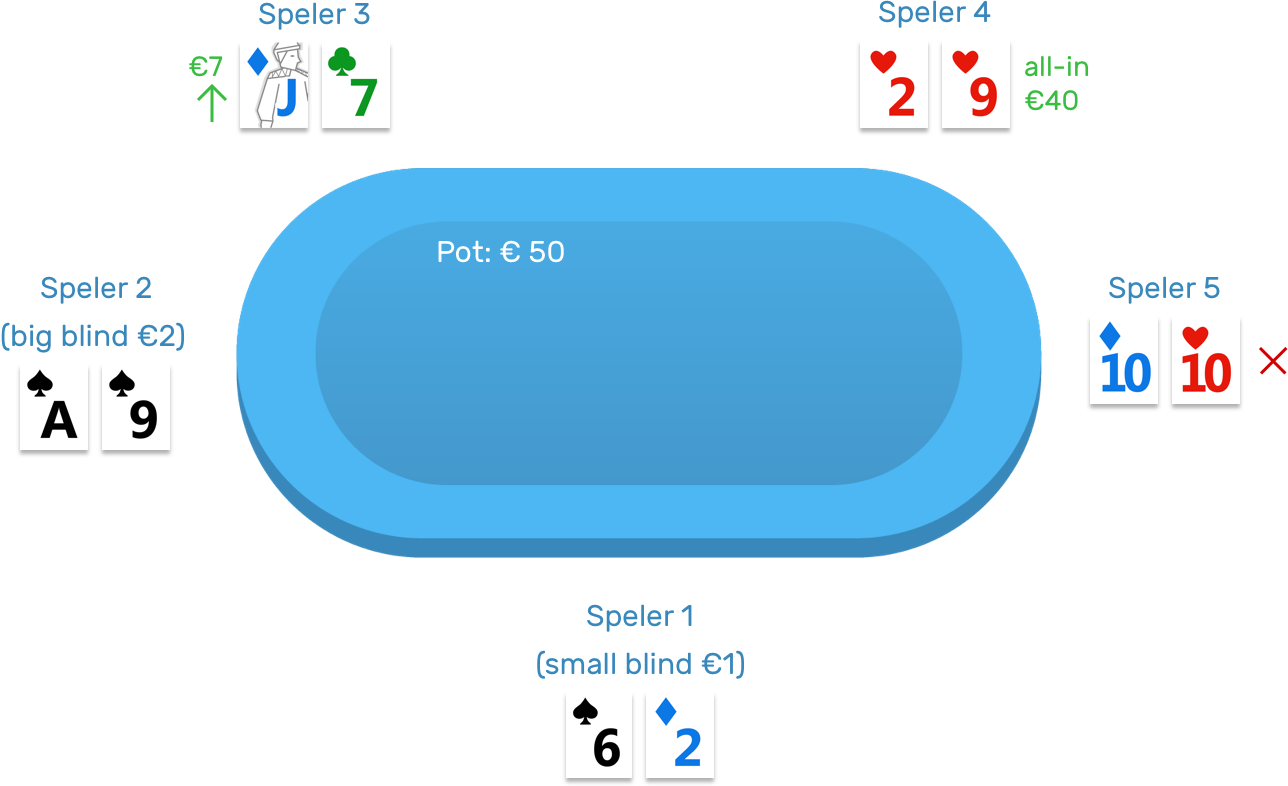
- Player 1 Has € 75 and folds.
- Player 2 Has € 100 and folds.
- Player 3 Has € 150, calls and adds € 2.
- Player 4 Has € 40 and goes all-in for € 40.
- Player 5Folds.
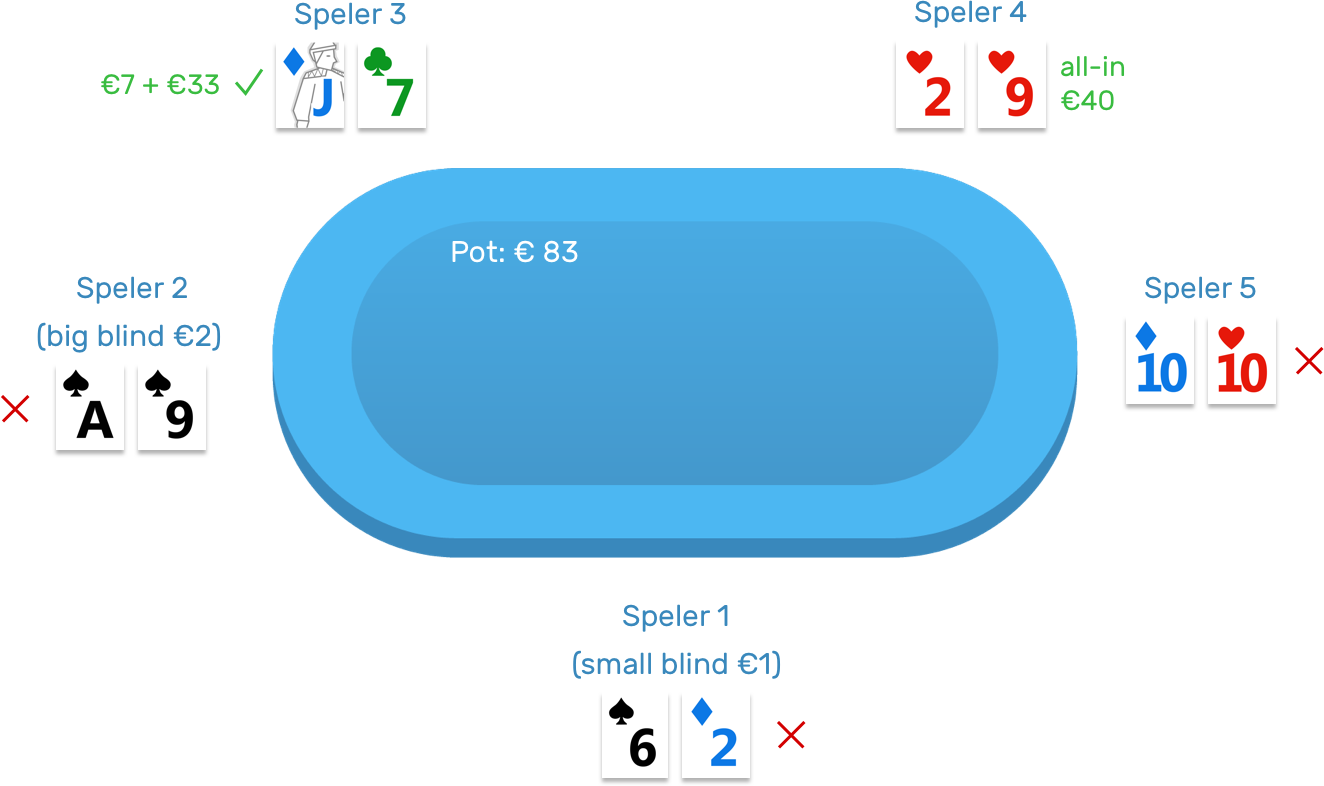
- Player 1Folds.
- Player 2Folds.
- Player 3Calls the all-in of € 40 and adds € 33. He doesn’t have to go all-in but he only has to pay the all-in of the other player.
The pot totals to € 83. The flop, turn and river are turned without making any further bets. After the river player 4 has to show his cards first (if he wants to win the pot). If player 4 shows his cards, player 3 has to show a better hand in order to claim the pot.
Side pot
If a player is all-in and multiple players remain a side pot can occur. The player that is all-in can’t win more than his own all-in from the other players. The other players, on the other hand, can bet among themselves. Those bets lead to a side pot. At the end of the hand the side pot is calculated first, after that the main pot.
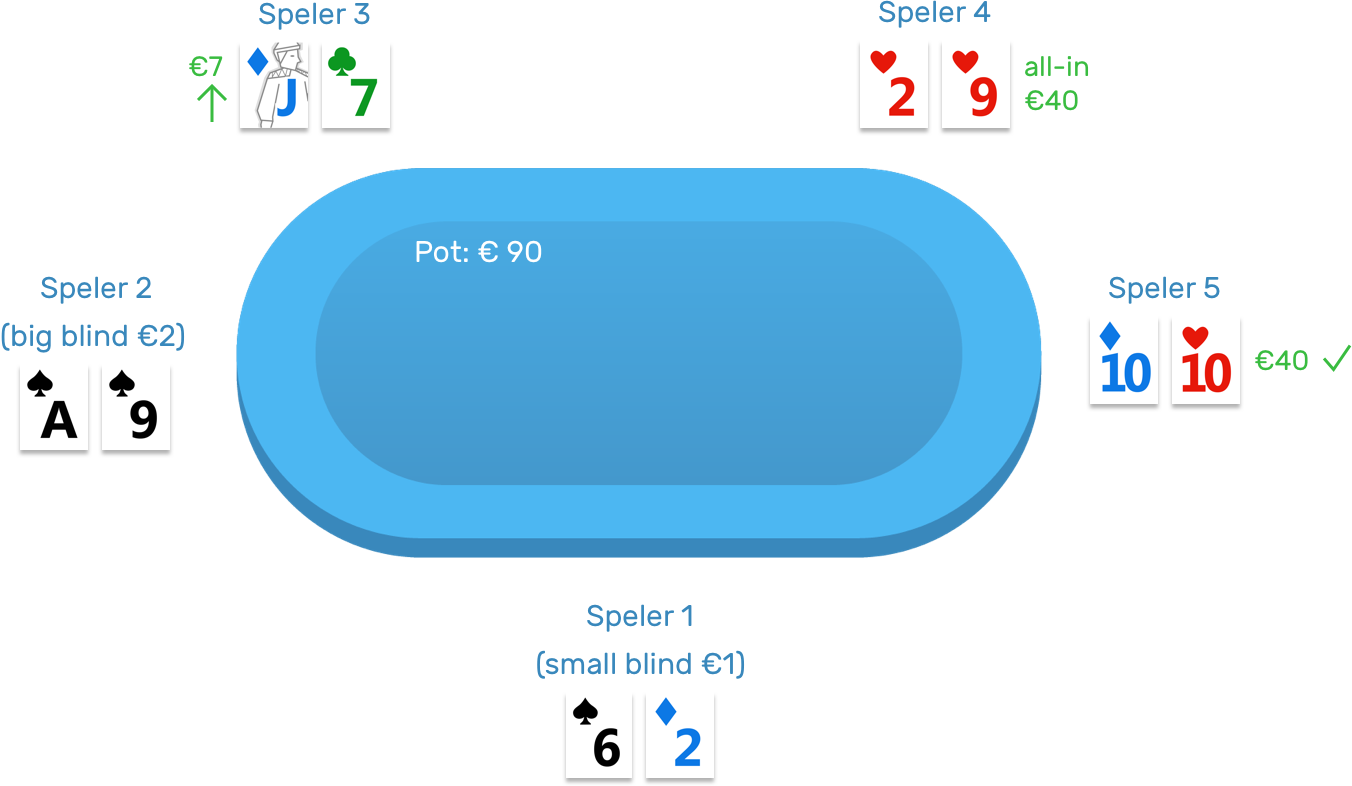
- Player 1 Has € 75. Places small blind € 1.
- Player 2 Has € 100. Places big blind € 2.
- Player 3 Has € 150. Raises to € 7.
- Player 4 Has € 40. Is all-in for € 40.
- Player 5 Has € 200. Calls € 40.
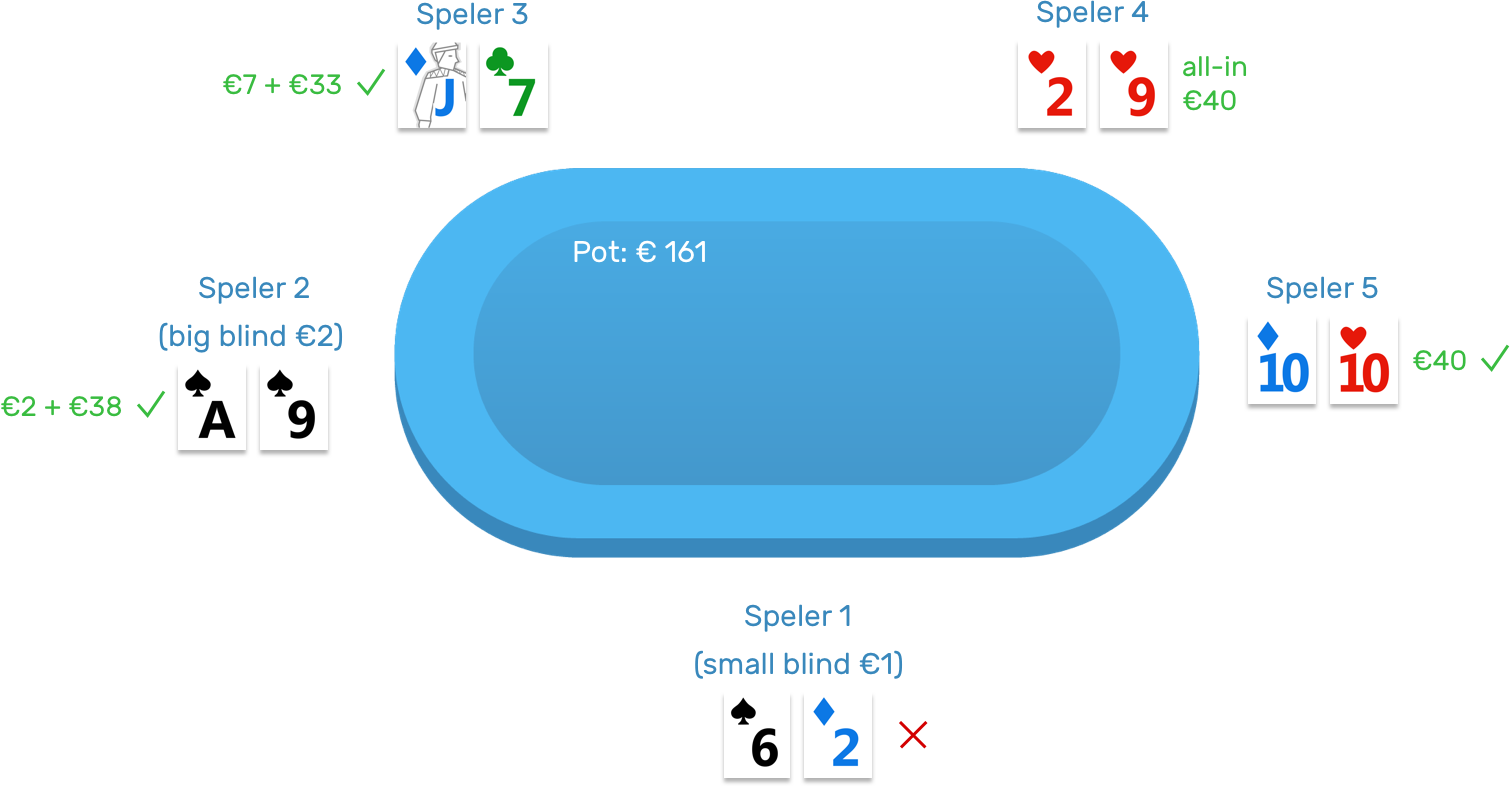
- Player 1Folds.
- Player 2Calls € 40.
- Player 3Calls € 40.
The pot consists of € 161 in total. This is the main pot for which all players qualify (except player 1 who already folded his cards).
After de flop
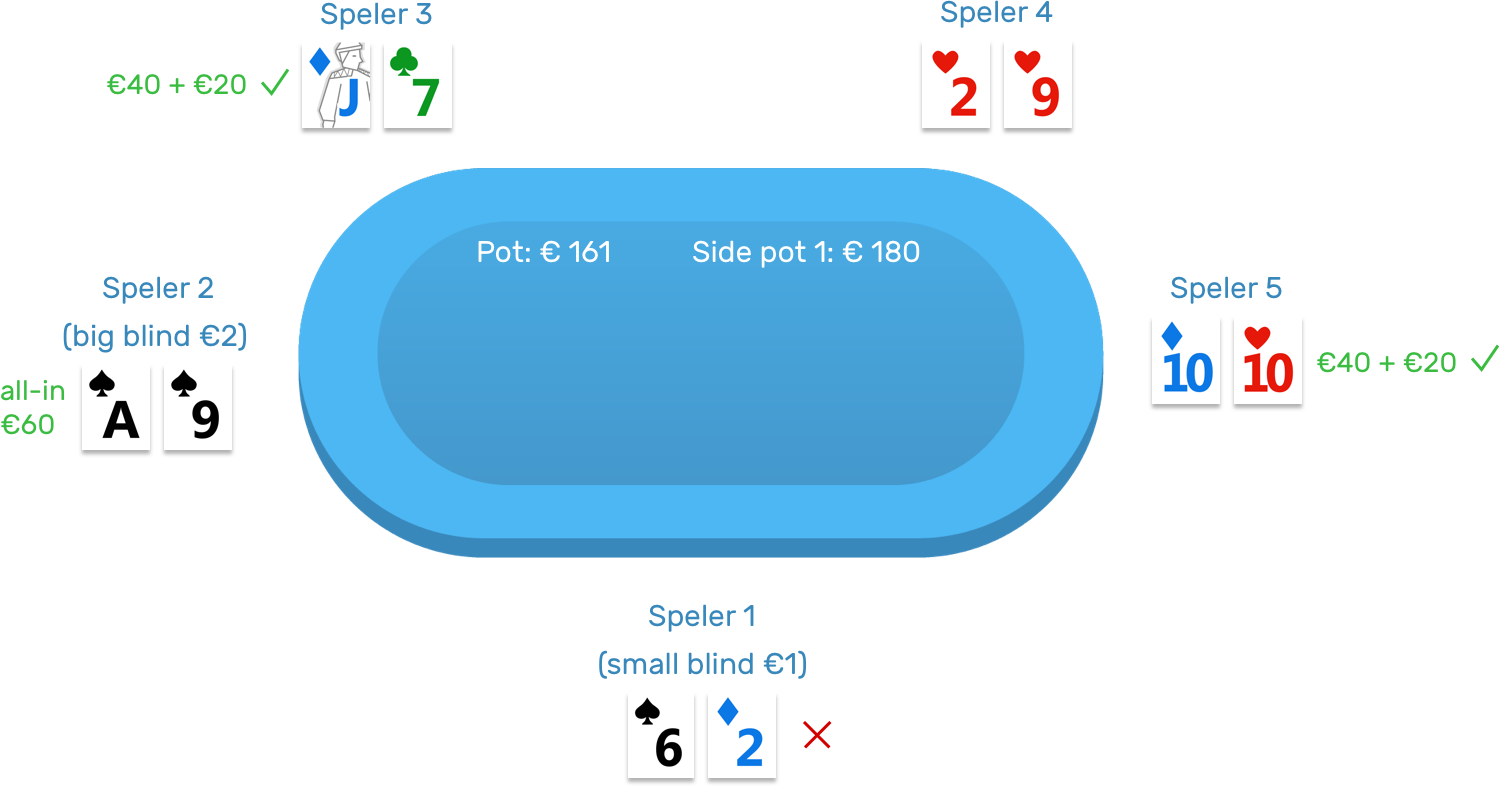
- Player 2Is all-in as well (€ 60).
- Player 3Calls € 60.
- Player 5Calls € 60.
A side pot is created of € 180 for which players 2, 3 and 5 qualify.
After de turn
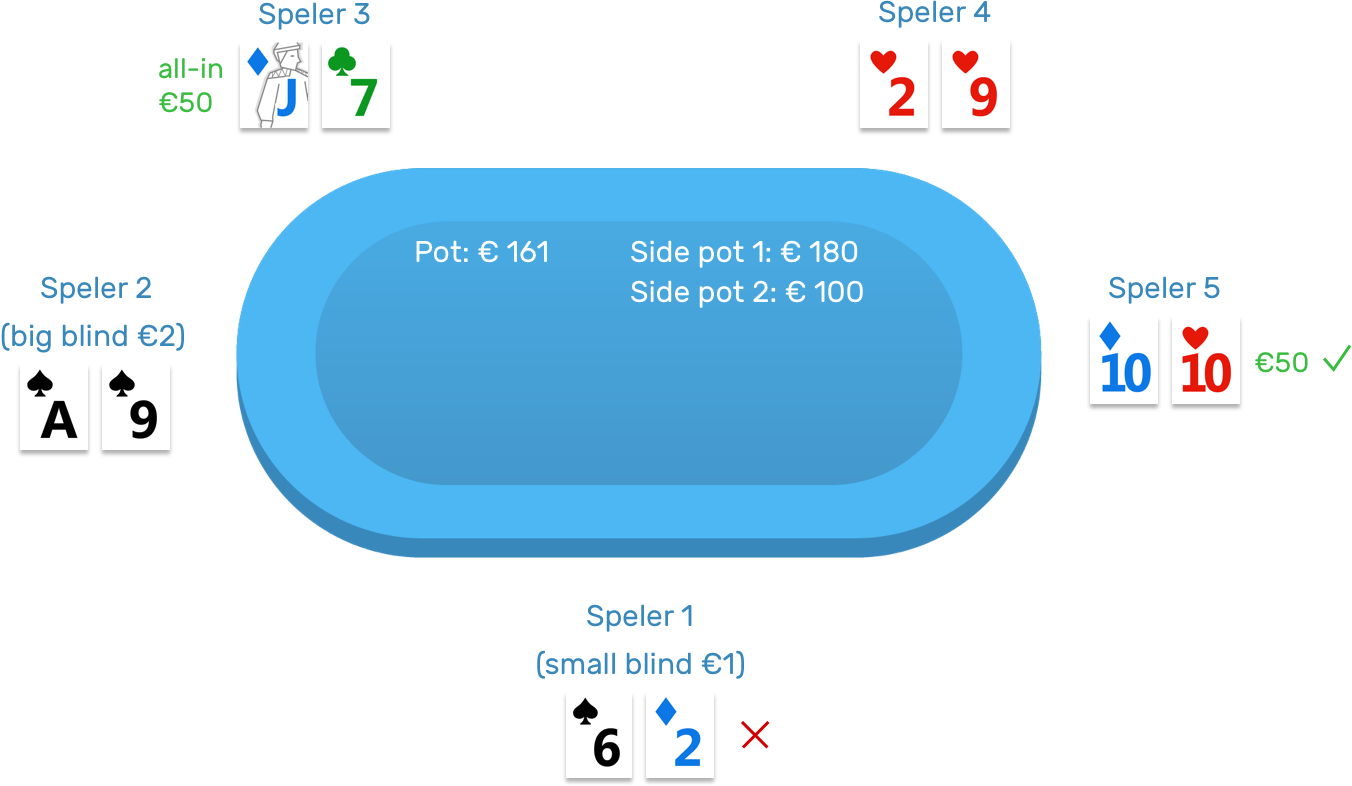
- Player 3Is all-in as well (€ 50).
- Player 5Calls € 50.
This creates a second side pot of € 100 for which players 3 and 5 qualify.
In a tournament the hands are now shown, in a cash game this is not necessary.
The river is turned. First we take a look at the second side pot of 100 euros. We compare the hands of players 3 and 5. The strongest hand wins this side pot.
Then we take a look at the side pot of € 180. We take into account the hand of player 2 here as well. The strongest hand of players 2, 3 and 5 wins and gets the side pot.
Finally we take into account the main pot for which player 4 qualifies as well. The hands of players 2, 3, 4 and 5 are compared. The best poker combination wins.
In other words: it is perfectly possible to have more than one side pot. It’s even possible for all different side (and main) pots to have a separate winner. But it’s also perfectly possible that one player wins all pots. (Only when that player qualifies for all pots of course.)


